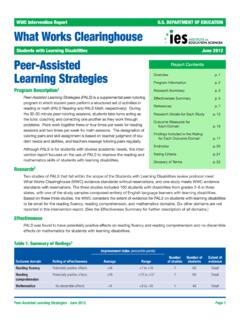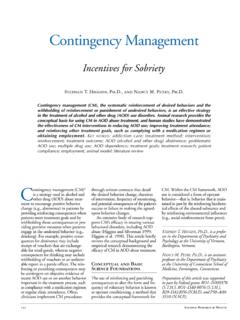Transcription of Effective Intervention for Serious Juvenile Offenders
1 Department of JusticeOffice of Justice ProgramsOffice of Juvenile Justice and Delinquency PreventionJohn J. Wilson, Acting AdministratorFrom the AdministratorAlthough research indicates that inter - vention programs can reduce overallrecidivism rates among Juvenile of-fenders, inadequate attention hasbeen paid to their impact on seriousjuvenile Bulletin describes a meta-analysisthat addresses the following questions:Can Intervention programs reduce re-cidivism rates among Serious delin-quents? If so, what types of programsare most Effective ?While the effects measured acrossthe 200 studies reviewed varied con-siderably, there was an overall de-crease of 12 percent in recidivism forserious Juvenile Offenders who re-ceived treatment Bulletin describes the interventionprograms that showed the strongest,most consistent impact on recidivismfor Serious Juvenile Offenders . The mosteffective interventions were interper-sonal skills training, individual coun-seling, and behavioral programs fornoninstitutionalized Offenders , andinterpersonal skills training andcommunity-based, family-type grouphomes for institutionalized information provided by this Bulletinand by the final report of OJJDP sStudy Group on Serious and ViolentJuvenile Offenders , cited by the authorsas a resource, should guide efforts toprovide Effective Intervention programsfor Serious Juvenile J.
2 WilsonActing AdministratorApril 2000uCan Intervention programs reduce recidi-vism rates among Serious delinquents?uIf so, what types of programs are mosteffective?The Bulletin describes the procedures usedto select studies for the meta-analysis,presents the methods of analysis used toanswer the above questions, and then dis-cusses Effective interventions for noninsti-tutionalized and institutionalized ProceduresThe results reported here were derivedby updating a previously conducted meta-analysis of the effects of Intervention ondelinquency (Lipsey, 1992, 1995) with morerecent studies. A subset of studies on seri-ous Offenders was selected from that meta-analysis, yielding 200 experimental or quasi-experimental studies of interventions forboth noninstitutionalized and institutional-ized Serious Offenders . The studies selectedfor the new database had the followingcharacteristics:uThe great majority, or all, of the juve-niles were reported to be adjudicateddelinquents.
3 Most had records of prioroffenses that involved person or prop-erty crimes or other, more Serious ,acts of delinquency (but not primarilysubstance abuse, status offenses, ortraffic offenses). Effective Interventionfor Serious JuvenileOffendersMark W. Lipsey, David B. Wilson, and Lynn CothernEffective Intervention plays an essentialrole in any strategy designed to diminishthe rates of Juvenile delinquency. Individ-uals who are employed in the Juvenile jus-tice system use Intervention as an impor-tant component of dispositional sanctionsimposed in Juvenile cases. This is particu-larly true for the treatment of Serious , vio-lent, and chronic Juvenile Offenders (seri-ous Offenders ) who have the potential forlong and harmful criminal careers andwho, absent Effective interventions , arelikely to recidivate while at the age forpeak interventions are most Effective indealing with the Serious offender? Althoughrecent research reviews have shown thatsome Intervention programs result in low-ered recidivism among youthful Offenders ,the reviews have only asked whether inter - vention is generally Effective (Andrews etal.)
4 , 1990; Cullen and Gilbert, 1982; Garrett,1985; Gendreau and Ross, 1987; Lipsey,1992; Palmer, 1994). Little systematic at-tention has been given to the effectivenessof interventions with distinct types of of-fenders, and little Intervention researchhas looked specifically at Serious Bulletin presents the results of ameta-analysis (a systematic synthesis ofquantitative research results) that posedtwo questions:2uFor noninstitutionalized juveniles, theinterventions studied included counsel-ing, skill-oriented programs, and mul-tiple services (combinations of servicesor treatments that involved several dif-ferent approaches). For institutional-ized juveniles, they included counseling,skill-oriented programs, and communityresidential programs. Treatments usu-ally lasted 1 to 30 weeks and involvedcontinuous contact or sessions thatranged from once or twice per week todaily, for 1/2 hour to 10 hours per half of the studies used randomassignment to experimental conditions;many of the others used some form ofmatching.
5 Control groups typically re-ceived the usual treatment ( , regularprobation or institutional programs).The recidivism outcome variables thatwere measured most frequently werepolice contact or arrest, court contact,or parole Effect SizeOnly one recidivism outcome measure wasselected from each study. Police contact orarrest was selected if it was available; other-wise, officially recorded contact with juve-nile court or offense-based probation viola-tions were used because they are the mostcomparable to police arrest. The differencebetween the treatment and control groupson the selected recidivism measure was cal-culated for each study and standardized sothat different measures could be , juveniles who received treatmentshowed an average 12-percent decrease inrecidivism. This result, while not enormous,was positive, statistically significant, andlarge enough to be meaningful. More impor-tant, however, was the large variability inuThe referral to the Intervention programwas made by someone within the juve-nile justice system, or the juveniles wererecruited directly by the studies included were those in whichmost or all of the juveniles in the studyhad aggressive histories or those whosespecific purpose was to change aggres-sive Juvenile of Analysisand FindingsProfile of Studies in theDatabaseThe pool of studies selected for the meta-analytic database shared the followingfeatures.
6 UThey were conducted in the UnitedStates by psychologists, criminologists,or sociologists and were publishedafter sample populations were largelymale, mostly white or of mixed ethnicity,with an average age of 14 to 17 of the juveniles had prior two-thirds of the samples, some or allof the juveniles had a history of aggres-sive most of the samples, juveniles wereunder the supervision of the juvenilejustice system and were receivingcourt-ordered Intervention . In one-thirdof the sample groups, Juvenile justicepersonnel administered treatment. Inone-fifth of the groups, treatment wasadministered by mental health person-nel in public or private agencies. In theremainder of the groups, it was adminis-tered by other counselors, laypersons,or across studies. The remainder ofthis Bulletin explores the characteristics ofthe interventions that produced the largesteffects on in Study Methodsand ProceduresThe differences in methods and proceduresused in the studies are the first source ofvariability in effect size.
7 The use of a mul-tiple regression equation made it possibleto estimate what the mean effect size overthe 200 studies would be if all the studieswere uniform in method and method-adjusted effect sizes werethen analyzed in terms of various treat-ment variables to identify those producinglarger forNoninstitutionalizedJuvenilesThe database was divided into studies ofinterventions with noninstitutionalizedjuveniles and studies of interventions withinstitutionalized juveniles because the cir-cumstances of treatment are different andbecause the nature and response of the ju-veniles receiving treatment may differ. Thissection examines the effects of noninstitu-tional treatment using the method-adjustedeffect size values (discussed previously) inrelationship to four clusters of clusters, which were associated withmore than half of the variation among ef-fect sizes across the studies, are listed indecreasing order of magnitude:uJuvenile offender amount delivered ( , totalnumber of weeks and frequency oftreatment, and other ratings of treat-ment effectiveness).
8 UGeneral program model was further reduced to includeonly the variables in each category thatwere most closely related to interventioneffects on recidivism among noninstitu-tionalized Serious Juvenile Offenders . inter - vention effectiveness was associated withthe characteristics of the juveniles whoreceived treatment. The effects were largerfor more Serious Offenders (indicated bythe types of prior offenses that includedboth person and property offenses) thanfor less Serious Offenders . Type of treatmentwas important and is discussed in the nextsection. Longer treatment was positivelyassociated with effectiveness, whereas the3acteristics, and other differences) werefavorable. However, without understand-ing the variables contributing to thesedifferences, it is difficult to know whetherthe effectiveness calculated for this groupof treatments was due to the treatment orto another forInstitutionalizedJuvenilesOf the 200 studies analyzed, 83 dealt withprograms for institutionalized youth; ofthese programs, 74 were in Juvenile justiceinstitutions and 9 were in residential facili-ties under private or mental health admin-istration.
9 Using the same method of regres-sion analysis, researchers examined thesame four clusters of variables as in thesample of studies with noninstitutionalizedoffenders. The clusters associated withthe largest variation in method-adjustedeffect size were, in decreasing order ofmagnitude:uGeneral program amount delivered ( , totalnumber of weeks and frequency oftreatment, and other ratings of treat-ment effectiveness).uJuvenile offender model was further reduced (using thesame procedure described earlier) to weedout the weakest variables. This processindicated that the characteristics of insti-tutionalized juveniles accounted for thesmallest proportion of effect size was in contrast to noninstitutionalizedjuveniles, for whom Juvenile characteristicswere most important. This means that theconclusions yielded by this model neednot be differentiated by Juvenile character-istics such as age, gender, ethnic mix, orprior offense variables emerged that were impor-tant in terms of the amount of treatmentprovided.
10 First, monitoring to ensure thatall juveniles received the intended treat-ment was essential. Second, the length oftreatment was related to the size of treat-ment effect; that is, the longer the treat-ment (the average in this sample was 25weeks), the larger the effects. The type oftreatment also was important and is dis-cussed in the next program characteristics ( , theway in which a program is organized,staffed, and administered) were more re-lated to the size of recidivism effects thanthe type or amount of treatment. The larg-est treatment effects were found for well-established programs (2 years or older).However, the variable most strongly relatedto effect size was administration by men-tal health personnel, in contrast to juvenilejustice of Treatment andEffects on RecidivismThe different types of treatment for insti-tutionalized juveniles were grouped ac-cording to the magnitude of mean effectsizes and the consistency of effect , it is important to note that the smallnumber of studies forming the basis ofthese estimates limits the ability to drawstrong conclusions.
















